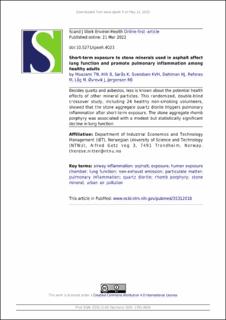| dc.description.abstract | Objective Stone minerals are a partially ignored environmental challenge but a significant contributor to urban air pollution. We examined if short-term exposure to two stone minerals – quartz diorite and rhomb porphyry – commonly used in asphalt pavement would affect lung function, promote pulmonary inflammation, and affect bronchial reactivity differently.
Methods Our randomized crossover study included 24 healthy, non-smoking young adults exposed to the stone minerals quartz diorite, rhomb porphyry, and control dust (lactose). Exposure occurred in an exposure chamber, in three separate 4-hour exposure sessions. Fractional exhaled nitric oxide (FeNO) and lung function were monitored before exposure, then immediately following exposure, and 4 and 24 hours after exposure. In addition, methacholine was administered 4 hours following exposure, and exhaled breath condensate (EBC) was collected before exposure, then immediately and 4 hours after exposure. EBC was analyzed for pH, thiobarbituric acid reactive substances (TBARS), intercellular adhesion molecule 1 (ICAM-1), interleukin-6 (IL-6), IL-10, P-Selectin, surfactant protein D (SP-D), and tumor necrosis factor-α (TNF-α).
Results Our results showed significantly elevated concentrations of FeNO after exposure to quartz diorite compared to rhomb porphyry, suggesting that quartz diorite is more likely to trigger pulmonary inflammation after short-term exposure. Moreover, short-term exposure to rhomb porphyry was associated with a modest but statistically significant decline in forced vital capacity (FVC) compared to quartz diorite.
Conclusion These results emphasize that using stone material in asphalt road construction should be reconsidered as it may affect lung inflammation and lung function in exposed subjects. | en_US |

